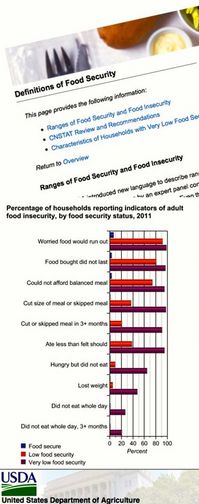Food for thought: Millions of us face food insecurity

Many Americans are planning for the Thanksgiving feast next week, but many other Americans don’t have enough to eat on a regular basis, never mind a holiday feast. Prevalent food insecurity is an American embarrassment. To what extent has the recession exacerbated the problem?
All week, we’ve discussed various aspects of food production, distribution, and access in America, using Tracie McMillan’s "The American Way of Eating" as our guide. We’ve covered myths about the poor and their preference for junk food, Walmart’s methods for providing cheap produce, the introduction of Whole Foods into the Detroit food desert, and Applebee’s stress-reducing function in society.
Today, we take another step and consider trends in food insecurity—how more Americans today go without eating or reduce their food intake.
Our headline today refers to “food insecurity,” a phrase most Americans understand at face value. But the terminology is changing:
”Low food security” is the label the U.S. Department of Agriculture currently uses to describe households that report reduced quality, desirability, or variety of diet. This used to be called food insecurity without hunger. "Very low food security” means that households report “multiple indications of disrupted eating patterns and reduced food intake.” This used to be called food insecurity with hunger.
The percentage of food-insecure households has jumped since the start of the recession in 2008, according to the USDA. From 1995 onward, the percentage had been dropping. The average percentage of food insecure households from 1995 to 2007 was 11.1 percent, and the percentage of households with very low food insecurity was 3.7 percent.
The averages from 2008 to 2011 are depressingly higher: 14.7 percent of households were food insecure, and 5.6 percent of households experienced severe food insecurity.
Households with children have higher rates than households without. Food insecurity is higher in urban areas than elsewhere. And food insecurity is higher in the South and the West, compared to other regions. Overall, 50.1 million Americans live in food-insecure households.
Seasonal food drives and donations help to alleviate the problem in the holiday months. But what happens during the rest of the year?
Do you feel food insecure?
What conditions do you see around you?
Wayne Baker is a sociologist on the faculty of the University of Michigan Ross School of Business. Baker blogs daily at Our Values and can be reached at ourvaluesproject@gmail.com or on Facebook.

